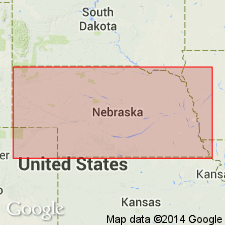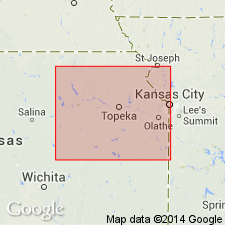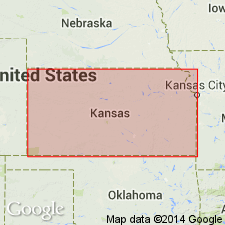
- Usage in publication:
-
- Krider limestone member
- Modifications:
-
- Original reference
- Dominant lithology:
-
- Limestone
- Shale
- AAPG geologic province:
-
- Nemaha anticline
- Chautauqua platform
Summary:
Pg. 60. Krider limestone. Middle member of Enterprise [shale] of Sumner group. Consists of (descending): (1) light-gray to buff limestone, 1 to 1.5 feet thick; (2) olive-drab to gray calcareous massive shale weathering buff, with usually a thin calcareous concretion near middle, 2.5 feet; (3) light-gray to buff massive limestone weathering buff, 1.5 feet. Thickness 4.5 to 6 feet from Nebraska to southern Kansas and Oklahoma. Underlies Paddock shale member and overlies Odell shale member. Fossils (DERBYA, COMPOSITA, AVICULOPECTEN, MYALINA, etc.). Age is Permian (Big Blue).
Type locality: exposures in road cut 0.25 mi south of Krider, in southwestern Gage Co., southwestern NE. Named from town of Krider.
Source: US geologic names lexicon (USGS Bull. 896, p. 1122); GNC KS-NE Permian Corr. Chart, Oct. 1936; supplemental information from GNU records (USGS DDS-6; Denver GNULEX).

- Usage in publication:
-
- Krider limestone
- Modifications:
-
- Revised
- AAPG geologic province:
-
- Nemaha anticline
- Chautauqua platform
Summary:
Pg. 12. Krider limestone member of Nolans limestone of Sumner group. Discarded Enterprise and treated Krider limestone as basal member of his Nolans limestone (new).
[GNC remark (ca. 1938, US geologic names lexicon, USGS Bull. 896, p. 1586): Krider limestone of Sumner group. Recognized in eastern Kansas and southeastern Nebraska. Age is Permian.]
Source: US geologic names lexicon (USGS Bull. 896, p. 1122); GNC KS-NE Permian Corr. Chart, Oct. 1936.

- Usage in publication:
-
- Krider limestone member
- Modifications:
-
- Revised
- Adopted
- AAPG geologic province:
-
- Nemaha anticline
Summary:
Pg. 163; R. C Moore and others, 1951, Kansas Geol. Survey Bull. 89, p. 41. Krider limestone member of Nolans limestone. Commonly two beds of limestone separated by bed of shale, each about 1 foot thick; in southern Kansas, the separating shale is somewhat thicker. Underlies Paddock sbale member; overlies Odell shale. Age is Permian (Wolfcampian).
Source: US geologic names lexicon (USGS Bull. 1200, p. 2058).
For more information, please contact Nancy Stamm, Geologic Names Committee Secretary.
Asterisk (*) indicates published by U.S. Geological Survey authors.
"No current usage" (†) implies that a name has been abandoned or has fallen into disuse. Former usage and, if known, replacement name given in parentheses ( ).
Slash (/) indicates name conflicts with nomenclatural guidelines (CSN, 1933; ACSN, 1961, 1970; NACSN, 1983, 2005, 2021). May be explained within brackets ([ ]).

